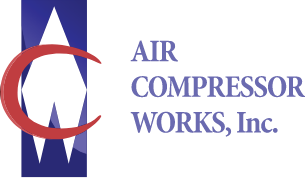Air Compressor Works
Post
Types of Desiccant Dryers
February 08, 2022

Types of Desiccant Dryers
Let’s go over the different types of Desiccant Dryers in a compressed air system.
Single Tower Desiccant Dryer
The simplest types of desiccant dryers. They are usually small and hang in line with the pipe. Filled with silica desiccant, the beads will change color when fully saturated. These dryers do not give a constant dew point. They start off with a lower dew point (determined by the inlet temperature,) and as the desiccant becomes more saturated, the dew point rises.
You’ll see these types of dryers in small paint booths and other smaller operations that need a dew point below 37F.
- Pros: Inexpensive, easy to install, no purge air
- Cons: Limited to smaller installations, short time between desiccant changing
Heatless Twin-Tower Desiccant Dryers
The most common desiccant dryers we see in the industrial compressor world. With a less-expensive upfront cost, they end up costing companies more on their electric bill because of purge air. Purge air is how this type of dryers regenerates it’s desiccant. There are two types of towers, one is for drying and the other is for regenerating. The regenerating tower has compressed air running through it and blowing it out. So basically, you have a huge leak to regenerate the desiccant.
- Pros: Inexpensive
- Cons: Purge air, more expensive electric bill
Heated Desiccant Dryers
These dryers not only blow air across the desiccant to dry it, but they heat it as well. The heated air holds more moisture and helps cook off some of the liquid water. By heating the air, it reduces the amount of purge air thus reducing electricity consumption. They cost about 50% more, but the return on investment is usually less than 2 years.
The discharge temperature of a heated desiccant dryer is 350F to 450F. You’ll need specialized high-temp filters that are usually included with the dryer, however, you still must account for the heat. The dryer must be insulated, along with the piping, and don’t forget the pressure ratings of pipe and fittings are determined by the temperature. Also, the heat can fry sensitive equipment downstream.
- Pros: Much less purge air than heatless = less expensive electric bill vs heatless
- Cons: Higher initial cost, extremely hot discharge air that require extra safety measures
Heated Blower Purge Desiccant Dryers
Almost identical to the heated desiccant dryer, other than a small side channel blower to purge the air. Using the side channel blower to purge the air is much less expensive than using the air from your air compressor. These dryers are usually more expensive than the heated and heatless dryers, but nearly always worth the extra investment.
- Pros: Very energy efficient compared to other desiccant dryers
- Cons: High initial cost, extremely hot discharge air that require extra safety measures
Heat of Compression Dryer
This dryer is used for a special situation – a non-lubricated rotary screw compressor with no aftercooler (or aftercooler is bypassed.) This dryer runs the hot (non-contaminated) discharge air and regenerates it first. Next the air moves through a heat exchanger to be cooled. Then the air runs through another sections to be dried. This type of dryer uses no more electricity than a toaster.
- Pros: Extremely energy efficient
- Cons: Very expensive initial cost, only suitable for one situation
Single Tower Blower Purge Dryer
This dryer has one large tower of desiccant. The tower is large enough to handle the rated flow from the compressor for 16 – 20 hrs. without needing regeneration. At the end of this cycle, it uses a heating element and a small side channel blowers to regenerate the desiccant. It usually takes around 4 – 8 hours to fully regenerate.
- Pros: Most efficient desiccant dryer, very durable, easy to troubleshoot
- Cons: Cannot be used in a 24/7 operation unless you double-up
Combination Desiccant/Refrigerated Dryer
A refrigerated dryer is placed before a heated blower purge dryer. The reason behind this is that running a refrigerated dryer is less expensive than the electricity to produce the purge air from the desiccant dryer. The best-case scenario for this type of dryer is when you only need a dew point that is 40F or above for your process, but you have temps that get below 40F. So, when it’s hot the dryer will run, and the desiccant won’t be involved until it gets cold.
Even when you need a lower dew point, this dryer is still very energy efficient. Not only is the electricity lower to run this setup, less moisture is going to the desiccant, in turn the desiccant lasts longer. Doubling the life from 5 to 10 years; significantly reducing maintenance costs.
- Pros: Very energy efficient, desiccant life doubles, built in redundancy if you don’t need a lower dew point.
- Cons: Very expensive, takes up significant floor space, complicated system
related post
Contact Us
Contact Us
Palm beach:
1956 W 9th St
Riviera Beach, FL 33404
Monday – Friday 7:30 AM - 4:30 PM
Map and Directions
Miami:
7292 NW 25th St
Doral, FL 33122
Monday – Friday 7:30 AM - 4:30 PM
Map and Directions
Phone Number:
Areas We Serve
- Miami
- Fort Lauderdale
- Hollywood
- Boca Raton
- Stuart
- Vero Beach
- Delray Beach
- West Palm Beach
- Homestead
- Key West
- Fort Pierce





